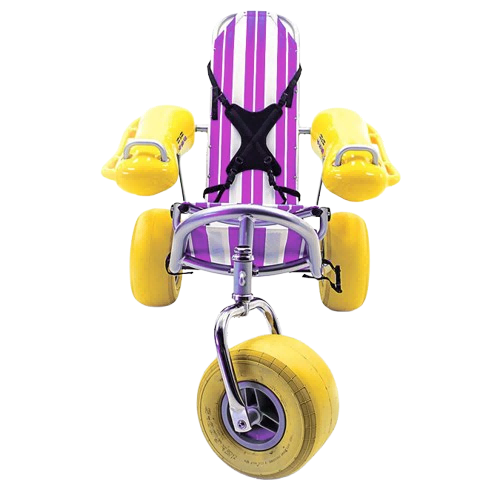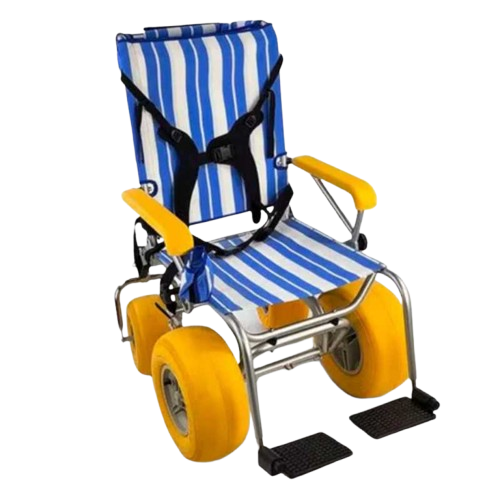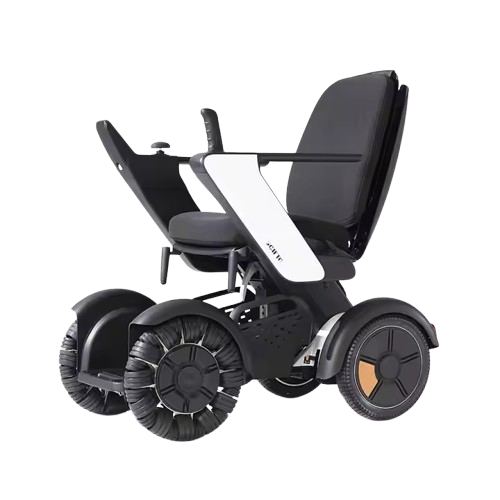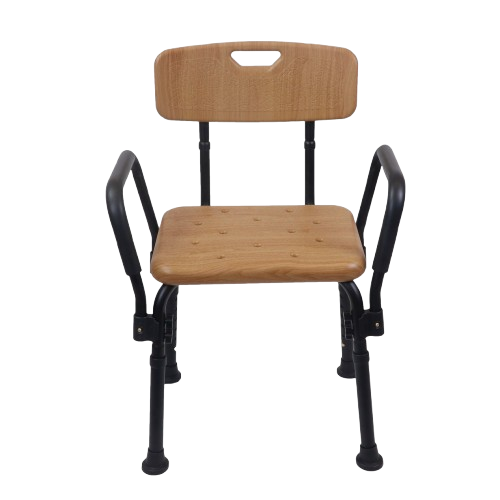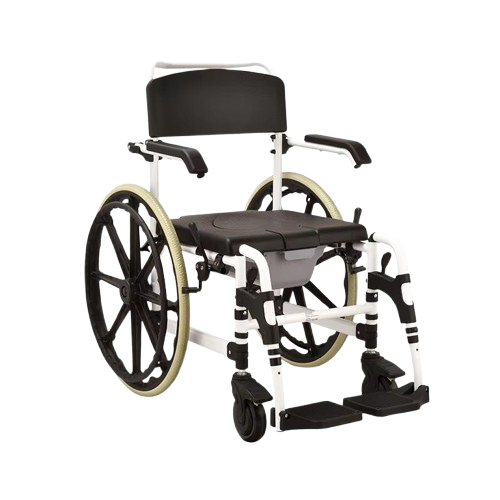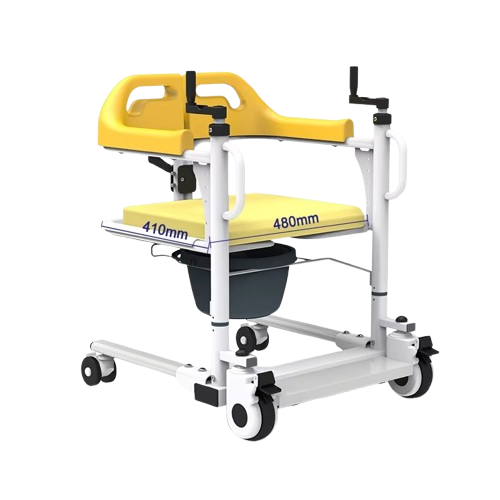Introduction
Imagine the sun kissing your skin, the salty breeze whispering through your hair, and the rhythmic crash of waves singing a timeless melody. For most of us, this picturesque beach experience is just a step away. But for individuals with mobility challenges, that tantalizing stretch of golden sand might as well be a world apart.
Enter the transformative world of beach wheelchairs—ingenious creations designed to bridge the gap between dreams and reality. These marvels of accessibility aren’t just about getting from point A to B; they’re about reclaiming freedom, rekindling joy, and immersing oneself in the beauty of coastal escapes. Whether it’s gliding effortlessly over the sand or floating serenely on the water, beach wheelchairs have revolutionized the way people experience the shoreline.
Gone are the days of watching from afar, yearning to be part of the fun. With beach wheelchairs, barriers vanish, and possibilities unfold. From spontaneous beach days with family to soul-soothing solo escapades by the water, they open the door to unparalleled inclusivity and adventure.
Ready to discover how these innovative mobility aids can redefine your beach experience? Let’s dive into the seven life-changing benefits that make beach wheelchairs an absolute game-changer.
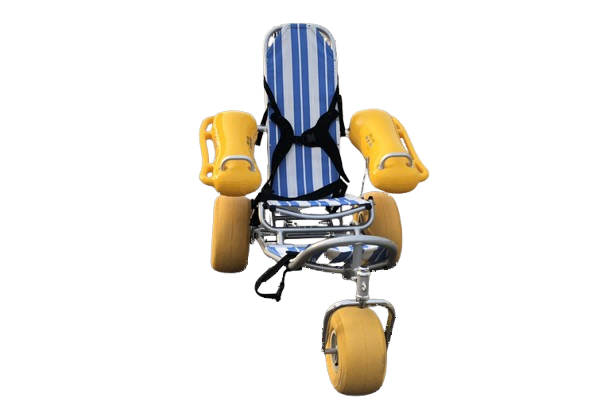
Freedom to Explore the Beach
Picture this: the vast, sun-drenched beach stretching out before you—golden sands beckoning you to explore. For those with mobility challenges, though, this vision often feels unattainable. That’s where beach wheelchairs come in, effortlessly bridging the gap between dream and reality. With their oversized, balloon-like wheels designed to glide over soft sand, they unlock a world of exploration that once seemed impossible.
Whether it’s strolling along the shoreline or venturing closer to the water’s edge, beach wheelchairs grant users the freedom to roam where standard wheelchairs simply can’t go. Imagine feeling the sun on your face, the waves licking your toes, and the sand beneath your wheels without the struggle or stress. It’s not just about mobility—it’s about liberation.
Beyond accessibility, this newfound freedom fosters a sense of adventure and independence. Whether you’re traveling solo or enjoying quality time with friends and family, beach wheelchairs make it possible to fully immerse yourself in the beach experience. For many, it’s not just about getting from point A to B—it’s about reconnecting with nature, exploring hidden coves, and relishing every sun-soaked moment.
Gone are the days of watching life unfold from the sidelines. Beach wheelchairs put you right in the heart of the action, making every beach day an opportunity to create memories without limits.
Enjoy Water Activities Without Barriers
There’s nothing quite like the feeling of floating on water—weightless, carefree, and completely in the moment. But for those with limited mobility, the idea of dipping into the sea can feel more like a fantasy than reality. Beach wheelchairs, especially floating models, change that narrative entirely, making water-based recreation not only possible but downright enjoyable.
Floating beach wheelchairs are specifically designed to transition seamlessly from sand to water, giving users the freedom to experience the ocean like never before. Equipped with buoyant, puncture-resistant tires and durable, rust-proof frames, these wheelchairs glide effortlessly into the waves without tipping or sinking. Picture yourself floating gently on the surf, surrounded by the sound of splashing water, with the sun shimmering on the surface around you.
Safety is paramount, and most models come with secure harnesses and comfortable seating to ensure stability and peace of mind. Whether it’s a leisurely float in shallow waters or dipping your toes in the surf while staying securely seated, floating beach wheelchairs let you savor the ocean’s embrace without worry.
The best part? You don’t need to rely solely on assistance from others. These wheelchairs empower users to take control of their beach experience, with easy maneuverability both in and out of the water. For many, it’s a life-changing opportunity to reconnect with the sea—an experience that’s as exhilarating as it is liberating.
Whether you’re soaking up the sun, enjoying a splash with family, or simply drifting with the waves, beach wheelchairs remove the barriers between you and the water, allowing you to indulge in one of life’s most cherished pleasures.
Social Inclusion and Family Bonding
Beaches are inherently social places—families laughing together, friends playing beach volleyball, and couples strolling hand-in-hand along the shore. Yet, for those with mobility challenges, being part of these moments can feel like an impossible dream. That’s where beach wheelchairs make a profound difference. They don’t just grant physical mobility—they restore the opportunity to be part of the social fabric that makes beach outings so special.
Imagine being able to join your family for a picnic right on the sand, rather than being stuck on a paved pathway at the edge of the beach. Or picture yourself rolling alongside friends as they explore tide pools, rather than waiting alone on solid ground. Beach wheelchairs dissolve the physical barriers that separate you from your loved ones, making it easier to stay connected and involved.
This sense of inclusion is more than just about fun—it’s about dignity and belonging. Whether it’s building sandcastles with your children, sharing stories around a beach bonfire, or simply being present for family photos, beach wheelchairs make it possible to actively participate without feeling isolated or left out.
It’s not just the users who benefit, either. Families and friends find comfort in seeing their loved ones fully included in beach activities, rather than sitting on the sidelines. The result? Stronger connections, more shared experiences, and a deeper sense of togetherness.
For anyone who’s ever felt like the beach is a place to watch rather than engage, beach wheelchairs offer a welcome invitation to dive back into social life—one sandy adventure at a time.
Increased Comfort and Ergonomics
Spending a day at the beach should feel like a retreat, not a test of endurance. Unfortunately, standard wheelchairs simply aren’t built for the rough, shifting terrain of sandy shores. They can feel rigid, uncomfortable, and even dangerous when navigating soft ground. Beach wheelchairs, on the other hand, are designed with comfort and ergonomics at the forefront, ensuring users can relax and enjoy the experience without constant discomfort.
One of the standout features is the plush, contoured seating that cradles the body and reduces pressure points. Unlike standard chairs that leave users feeling cramped and strained, beach wheelchairs provide ample support to alleviate muscle tension and minimize fatigue during long beach outings. Many models also feature adjustable reclining options, allowing you to kick back and soak up the sun or find the perfect angle for conversations and views.
Oversized, balloon-like wheels not only make for smooth movement across sand but also absorb shocks and vibrations, delivering a remarkably comfortable ride even over uneven surfaces. The stability of these wheels means you won’t be jostled or tipped, and you can glide effortlessly from sandy stretches to firmer ground without needing constant assistance.
Additionally, some advanced models include ergonomic push handles for caregivers, making it less of a chore to maneuver the chair. This thoughtful design ensures that both users and helpers can enjoy the day without feeling physically drained.
Comfort doesn’t end with seating and wheels—many beach wheelchairs also feature padded armrests and footrests, providing comprehensive support that feels more like lounging in a beach chair than being confined in a medical device. This attention to detail transforms beach outings from stressful experiences into rejuvenating escapes, where comfort and relaxation come naturally.
Gone are the days of battling stiff, uncomfortable chairs that make you dread long beach days. With a beach wheelchair designed for ergonomic bliss, you can fully unwind and immerse yourself in the sun, sand, and sea without a care in the world.

Versatile Use Beyond the Beach
While beach wheelchairs are renowned for their ability to conquer sandy shores, their versatility goes far beyond just the beach. These all-terrain marvels are built to handle a wide variety of outdoor environments, making them an invaluable investment for those who love to explore the great outdoors.
Imagine taking your beach wheelchair for a spin through a local park, gliding over grassy fields and unpaved trails with ease. Or navigating gravel paths during a lakeside picnic without worrying about the wheels getting stuck. The same design features that make these wheelchairs perfect for sand—such as oversized, low-pressure wheels and durable, corrosion-resistant frames—also make them highly effective on other challenging terrains.
Some users have found incredible freedom in using their beach wheelchairs at hiking spots, nature reserves, and even snow-covered paths. The adaptive features that provide traction and stability on sand work just as well on mud, rocky surfaces, and packed snow. Whether it’s exploring botanical gardens or tackling woodland trails, the possibilities are endless.
Additionally, many beach wheelchairs are foldable or easily disassembled, making them surprisingly portable. This means you can load them into your vehicle and take them wherever your adventures lead. No need to worry about swapping equipment or limiting your plans—your trusty beach wheelchair has got you covered.
Versatility also means practicality. Families who invest in a beach wheelchair find themselves using it beyond vacations. Whether it’s attending outdoor events, festivals, or community gatherings on uneven ground, the beach wheelchair quickly becomes a reliable companion for a wide range of social and recreational activities.
When it comes to mobility aids, why settle for something limited? A beach wheelchair is more than just a way to reach the water—it’s a passport to an adventurous and active lifestyle, allowing you to embrace new experiences with confidence and comfort.

Psychological and Emotional Well-Being
The power of nature to uplift the human spirit is undeniable. There’s something inherently rejuvenating about feeling the sun on your face, hearing the waves crash, and breathing in the salty air. But for many people with mobility challenges, that revitalizing beach experience often feels out of reach. Beach wheelchairs do more than just provide physical mobility—they also offer profound psychological and emotional benefits that can’t be overlooked.
One of the most significant impacts of using a beach wheelchair is the sense of freedom it restores. Being able to move independently across the sand and even into the water creates a powerful feeling of empowerment. It’s more than just mobility; it’s reclaiming a sense of autonomy and choice. No longer confined to the boardwalk or the parking lot, you can join family and friends without feeling left out or dependent on others.
There’s also an undeniable boost in self-confidence that comes from knowing you can navigate the beach just like anyone else. Whether it’s rolling up to a beach volleyball game, joining in on a seaside picnic, or simply soaking in the sunset from the shoreline, the ability to be present and fully engaged brings immense satisfaction and pride.
Studies have shown that spending time in nature can reduce stress, alleviate symptoms of anxiety, and improve overall mood. The mental health benefits of being outdoors are amplified when you feel fully included and unrestricted in your environment. Beach wheelchairs make it possible to immerse yourself in the calming, restorative qualities of the ocean without barriers or limitations.
For some users, the experience is nothing short of transformative. The simple joy of feeling the sand under their wheels or dipping their toes in the surf reignites a sense of connection with nature that was thought to be lost. It’s not just about getting to the beach—it’s about rekindling a sense of normalcy and joy, breaking free from the confines of everyday challenges, and embracing the therapeutic power of the great outdoors.
When your mobility device not only grants you physical access but also restores your mental and emotional well-being, it’s more than just equipment—it’s a life-enhancing companion that empowers you to thrive.
Access to a Range of Models and Features
One of the most exciting aspects of beach wheelchairs is the sheer variety of models available. No two users are alike, and neither are their needs or preferences. Whether you’re looking for a manual option for self-propulsion or an electric model for effortless movement, there’s a beach wheelchair tailored to your lifestyle.
Manual beach wheelchairs are popular for their simplicity and lightweight design. These models typically feature oversized balloon wheels that glide smoothly over sand while being easy to push or self-propel. They are perfect for users who want to maintain some physical activity while enjoying the beach. Plus, they’re often more compact and portable, making them a great choice for family beach outings.
Electric beach wheelchairs take accessibility to the next level. With powerful motors and rugged, sand-friendly tires, these models let users independently navigate long stretches of shoreline without needing assistance. They’re ideal for those who want complete autonomy and the ability to explore without relying on a caregiver. Some electric models even feature reclining seats and adjustable footrests for added comfort.
For water enthusiasts, floating beach wheelchairs are a game-changer. Designed to transition seamlessly from sand to water, these chairs are buoyant, stable, and safe to use in shallow surf. They provide users with the unique experience of floating while remaining comfortably seated, opening up a whole new world of aquatic activities.
Customizable options are also available, allowing users to choose features that best suit their preferences. From padded seating and headrests to built-in storage compartments and UV-resistant materials, the possibilities are endless. Some models even come with interchangeable wheels to adapt to different terrains, making them versatile companions beyond just the beach.
Selecting the right model comes down to understanding your specific needs and the type of terrain you’ll encounter. Are you looking for something easy to transport? Consider a folding manual model. Want the freedom to explore without help? An electric version might be your best bet. Love the water? Opt for a floating chair.
When you choose a beach wheelchair that matches your lifestyle, you’re not just investing in mobility—you’re investing in freedom, independence, and the chance to experience the beach on your own terms.
How to Choose the Right Beach Wheelchair
Selecting the perfect beach wheelchair can feel overwhelming with so many options available. But don’t worry—finding the right fit is easier than you think when you know what to look for. Whether you’re planning casual beach outings or frequent adventures, here’s a breakdown of how to make the best choice.
- Assess Your Needs and Preferences
Start by considering how you’ll use the wheelchair. Are you looking for a model that glides effortlessly over soft sand or one that can float on water? Will you be using it independently, or will someone else be pushing it? Identifying your primary needs will help narrow down the options. - Consider the Terrain
Different beaches have different sand textures—some are fine and powdery, while others are coarse and gritty. If your favorite beach has soft, sinking sand, opt for a model with oversized balloon tires designed to distribute weight and prevent sinking. For rougher terrains or rocky shorelines, durable, heavy-duty wheels are essential. - Manual vs. Electric
Manual beach wheelchairs are generally lighter and easier to transport, but they require physical effort to move. If you have upper body strength and prefer self-propulsion, this might be your best bet. On the other hand, electric models offer effortless navigation and are ideal for users who want independence without exertion. However, they tend to be heavier and may require more maintenance. - Floating vs. Non-Floating Models
If you’re planning to venture into the water, a floating beach wheelchair is a must. These models feature buoyant tires and rust-resistant frames, making them perfect for shallow surf and calm waters. Non-floating models, while still beach-friendly, are better suited for staying on dry land. - Comfort and Adjustability
Comfort is key when spending long hours at the beach. Look for models with padded seating, reclining backrests, and adjustable footrests. Some high-end options even include headrests and arm supports, allowing you to relax fully while soaking up the sun. - Portability and Storage
Consider how easy it is to transport the wheelchair. Foldable or easily disassembled models are ideal if you plan to take them on trips or store them in small spaces. Check the overall weight and whether it fits comfortably in your vehicle. - Maintenance and Durability
Beach environments can be harsh on equipment, so choose a model built with corrosion-resistant materials like aluminum or stainless steel. Look for UV-resistant fabric that won’t fade or degrade under the sun. Regular maintenance is also crucial—ensure that the wheels and frame can be easily cleaned and maintained after exposure to sand and saltwater. - Budget Considerations
Beach wheelchairs range from affordable manual models to high-end electric versions. Set a budget, but keep in mind that investing in quality and durability will save money in the long run. Look for warranties and customer reviews to ensure you’re getting the best value. - Try Before You Buy
If possible, visit a showroom or rental service to test different models. Feeling how they maneuver on sand and assessing comfort firsthand will give you the confidence to make the right choice.
Choosing the right beach wheelchair means balancing functionality, comfort, and affordability. With the right selection, you’re not just buying a mobility aid—you’re investing in endless beach adventures and the freedom to explore the world on your terms.

Tips for Safe and Effective Use of Beach Wheelchairs
Using a beach wheelchair opens up a world of possibilities, but it’s essential to keep safety in mind to make the most of your experience. Whether you’re cruising along the shoreline or floating in the waves, these practical tips will help you stay safe and enjoy every moment.
1. Prepare Before You Go\
Before heading out, inspect your beach wheelchair to ensure it’s in good condition. Check the wheels for any damage or excessive wear, and make sure all fasteners and straps are secure. Bring any necessary tools and cleaning supplies just in case you need to make adjustments on the go.
2. Choose the Right Location\
Not all beaches are equally accessible, so research your destination beforehand. Look for beaches with designated wheelchair access paths, ramps, and parking spots. Many popular beaches offer wheelchair rentals or have beach mats to make navigation easier.
3. Stay Hydrated and Protected\
Beach days can be long and hot, so pack plenty of water to stay hydrated. Wear sunscreen and a wide-brimmed hat to protect yourself from the sun’s rays. Bring a lightweight, breathable cover for your wheelchair seat to avoid burns from hot surfaces.
4. Practice Safe Water Entry and Exit\
If using a floating beach wheelchair, make sure you have a support person to assist with entry and exit from the water. Always double-check the stability of the chair before transitioning to ensure it doesn’t tip or sink. Once in the water, remain in shallow areas and avoid rough waves for maximum safety.
5. Secure Yourself Properly\
Adjust your seatbelt and straps before moving. Floating models often include extra harnesses for added security—use them even if the water looks calm. Comfort and stability are key to preventing accidents, especially when transitioning from land to water.
6. Navigate Smartly on Sand\
When moving across soft sand, keep your pace steady and avoid sharp turns that could cause the wheels to dig in. If you feel resistance, back up slightly and change your approach angle. Pushing from behind rather than pulling from the front typically yields better control.
7. Regular Maintenance and Cleaning\
After every beach trip, thoroughly rinse your beach wheelchair with fresh water to remove salt and sand. Pay extra attention to the wheels and bearings to prevent corrosion. Dry the chair completely before storing it to avoid rust and mold.
8. Know Your Limits\
Even the most rugged beach wheelchair has its limitations. Be mindful of changing tides and weather conditions, and don’t push yourself too far. Always have a backup plan and communicate with your companions about your needs.
9. Seek Assistance When Necessary\
Whether it’s navigating steep dunes or transitioning from the wheelchair to a beach lounger, don’t hesitate to ask for help. Most people are more than willing to lend a hand, and staying safe is worth the extra support.
10. Emergency Preparedness\
Keep a basic first-aid kit on hand and carry a mobile phone in a waterproof case. In case of any issues, having immediate access to emergency contacts or local lifeguards can make all the difference.
With these safety tips in mind, you can focus on enjoying the beach with confidence and peace of mind. Whether it’s your first beach adventure or your hundredth, prioritizing safety will ensure your day is nothing short of spectacular.
Beach Wheelchair Etiquette and Considerations
Beach wheelchairs open up a world of freedom and adventure, but it’s essential to be mindful of how they impact your surroundings and interactions. Whether you’re navigating crowded beaches or exploring secluded spots, practicing good etiquette ensures a positive experience for everyone involved. Here are some key etiquette tips and considerations to keep in mind:
1. Be Mindful of Your Space\
Even though beach wheelchairs are designed to handle sand and rough terrain, they can still take up more space than standard chairs. Be courteous when moving through crowded areas, giving others ample room to pass by. Position yourself thoughtfully when stopping to avoid obstructing walkways or access points.
2. Respect Shared Beach Spaces\
While it’s exciting to explore the beach with newfound mobility, remember that not everyone is accustomed to seeing wheelchairs on the sand. Be patient with curious onlookers, and if they ask questions, take the opportunity to educate them about the wheelchair’s features and benefits.
3. Communicate with Lifeguards and Beach Staff\
Before venturing too far from designated areas, check in with local lifeguards or beach staff. Let them know your plans, especially if you’re using a floating wheelchair or plan to enter the water. They can offer helpful guidance and keep an extra eye out for safety.
4. Keep Pathways Clear\
When taking breaks or parking your wheelchair, ensure you’re not blocking pathways, boardwalks, or accessible ramps. Choose a spot that doesn’t disrupt the natural flow of beachgoers and allows easy access for other wheelchair users.
5. Educate and Inspire\
Sometimes, seeing a beach wheelchair in action can be inspiring for others who may not have considered beach outings possible. Share your positive experiences openly and encourage conversations that promote accessibility and inclusivity. Your presence at the beach can empower others to break free from limitations and embrace the joy of outdoor adventures.
6. Practice Good Environmental Stewardship\
As you enjoy the beach, remember to minimize your environmental footprint. Be careful not to damage fragile dune ecosystems or disturb wildlife habitats. Dispose of trash properly, and encourage those around you to do the same. By leading by example, you can show that accessibility and environmental responsibility go hand in hand.
7. Support Community Efforts for Accessibility\
Be proactive in supporting local initiatives that promote beach accessibility. Whether it’s advocating for more accessible paths, donating to inclusive programs, or volunteering to assist with accessibility projects, your involvement helps build a more welcoming environment for all.
8. Acknowledge and Appreciate Helpers\
If friends, family, or even strangers assist you with maneuvering the wheelchair or navigating tricky spots, express your gratitude. A simple thank you goes a long way in fostering kindness and community spirit.
9. Share Your Experience\
After your beach day, consider leaving feedback or reviews for the beach facilities, highlighting both positives and areas for improvement. This not only helps future visitors with mobility challenges but also encourages venues to continue enhancing their accessibility features.
10. Celebrate the Moment\
At the end of the day, beach wheelchairs are about freedom and joy. Soak in the experience, savor the sights and sounds, and share your story with others. Whether it’s through social media, blogs, or conversations with friends, your journey can inspire and motivate countless others to embrace their own adventures.
Practicing good etiquette and being mindful of others not only enhances your beach day but also fosters a sense of community and inclusivity. Enjoy your time on the sand with confidence, knowing that your presence makes a positive impact on how the world views accessibility and outdoor exploration.
Real Stories of Beach Wheelchair Users
There’s nothing quite as powerful as hearing from those who have experienced the transformative impact of beach wheelchairs firsthand. These real stories not only inspire but also demonstrate how access to the beach can change lives, restore confidence, and create unforgettable memories.
1. Sarah’s Story: Reclaiming Freedom\
Sarah was an avid beach lover before a spinal injury left her feeling disconnected from her favorite pastime. For years, she would sit on the boardwalk, watching her family play in the waves, her heart aching to join them. Everything changed when she discovered a floating beach wheelchair. For the first time in years, Sarah was able to float alongside her kids, laughing and splashing without a hint of fear or frustration. The wheelchair gave her back more than just mobility—it restored her sense of freedom and belonging.
2. Mike’s Adventure: Conquering the Sand\
Mike is an adventurous spirit who never lets his mobility challenges hold him back. Determined to experience every corner of his local coastline, he invested in a rugged, all-terrain beach wheelchair. With oversized tires and a lightweight aluminum frame, Mike now regularly embarks on coastal treks, navigating sandy dunes and rocky paths without missing a beat. “It’s more than just a chair,” he says. “It’s a ticket to adventure.”
3. Emma’s Family Bonding Moment\
For Emma, beach days with her young children used to be bittersweet. While they ran through the sand and chased waves, she remained stuck on the concrete pathway, unable to join the fun. That changed when her husband surprised her with a manual beach wheelchair. Now, family outings are a whole new experience. Whether building sandcastles or wading into the shallow surf, Emma feels fully involved and connected. Her children no longer run ahead—they joyfully push her along, laughing as they race toward the water.
4. James’s Journey: Rediscovering Confidence\
James had long struggled with the feeling of being left out during beach outings with friends. Watching from a distance made him feel isolated and frustrated. One day, a local community organization introduced him to beach wheelchairs available for public use. At first hesitant, James gave it a try, and the experience was nothing short of transformative. Rolling confidently across the sand and joining his friends for a game of beach soccer, he felt his self-esteem soar. He now advocates for better accessibility in his community, hoping to give others the same sense of empowerment.
5. Lily’s Floating Dream\
Lily always loved swimming but hadn’t felt the water on her skin in over a decade due to her limited mobility. When she first used a floating beach wheelchair, tears filled her eyes as she glided effortlessly through the water. The feeling of buoyancy and freedom reignited her love for the ocean. Now, she visits the beach regularly, no longer as an observer but as an active participant in the waves.
6. Community Efforts: Making Accessibility Possible\
Sometimes, it’s not just individual stories but community-driven efforts that make the difference. In one coastal town, local businesses and volunteers raised funds to purchase beach wheelchairs and set up accessible pathways. Visitors from all over now flock to this inclusive beach, where everyone can experience the sand and surf without barriers. Hearing stories of visitors expressing their gratitude and joy reminds the community why accessibility matters.
7. Families Speak Out: How Beach Wheelchairs Strengthen Bonds\
Numerous families have shared how beach wheelchairs have strengthened their relationships. Grandparents who thought their beach days were over now build sandcastles with their grandchildren. Parents who once sat on the sidelines now join their kids in exploring tide pools and chasing waves. These stories highlight how inclusivity enhances family unity, creating memories that last a lifetime.
The Power of Personal Experiences\
Hearing real stories from beach wheelchair users reveals the profound impact these devices have on quality of life. Whether it’s regaining a sense of independence, rediscovering the joy of water, or creating lasting family moments, beach wheelchairs are more than just mobility aids—they’re catalysts for life-changing experiences.
These stories not only illustrate the practical benefits but also emphasize the emotional and psychological transformation that occurs when barriers are broken down. It’s proof that everyone deserves the chance to feel the sand beneath their wheels and the ocean breeze on their face.
FAQs About Beach Wheelchairs
Beach wheelchairs have gained immense popularity for their ability to make sandy shores accessible, but many people still have questions about how they work, where to find them, and how to use them safely. Here are the most frequently asked questions about beach wheelchairs, along with straightforward answers to help you get the most out of your beach adventure.
1. Can beach wheelchairs be rented at popular destinations?\
Yes! Many popular beach destinations and coastal resorts offer beach wheelchair rentals. Public beaches and parks often have accessible equipment available for free or at a minimal cost. It’s best to call ahead or check the official website of the beach you plan to visit to confirm availability and reservation requirements.
2. How much do beach wheelchairs typically cost?\
The cost of beach wheelchairs varies significantly based on features and build quality. Manual models can range from $1,000 to $2,500, while electric models may cost between $3,000 and $6,000. Floating beach wheelchairs usually fall within the $1,500 to $3,500 range. Rental prices can vary from $30 to $75 per day, depending on the location and model.
3. Are they covered by insurance or community programs?\
Coverage varies by region and insurance policy. Some health insurance plans may cover part of the cost, especially if prescribed for medical reasons. Additionally, non-profit organizations and community initiatives sometimes offer financial assistance or provide wheelchairs for public use. Be sure to check with local disability advocacy groups for resources and support.
4. Can beach wheelchairs handle rocky or uneven terrain?\
Many beach wheelchairs are specifically designed for soft sand and may struggle on rocky terrain. However, some models are equipped with all-terrain wheels that can manage both sand and rough surfaces. It’s essential to choose a model that matches your intended use and terrain.
5. How do floating beach wheelchairs work?\
Floating beach wheelchairs have specially designed buoyant tires and frames that keep them stable in the water. Users are securely strapped into the seat, and the wheels allow easy movement on both sand and shallow water. Always have a support person available when entering or exiting the water for safety.
6. Are beach wheelchairs easy to transport?\
Yes, many models are designed to be foldable or easily disassembled, making them convenient for transport. Check the product specifications for weight and compactness before purchasing or renting, as this can vary by model.
7. Do I need a special permit to use a beach wheelchair?\
Generally, no permits are required to use a beach wheelchair, but it’s always good practice to familiarize yourself with local beach regulations and accessibility guidelines.
8. Can I take a beach wheelchair on vacation?\
Absolutely! Many travelers bring their own beach wheelchairs to ensure accessibility at their destination. Airlines often accommodate mobility devices without extra charges. Contact your airline ahead of time to make necessary arrangements.

Conclusion
Beach wheelchairs are more than just mobility aids—they’re life-changing tools that redefine how individuals with limited mobility experience the outdoors. From the freedom to explore sandy shores to the joy of floating in the ocean, they break down barriers and create unforgettable memories. Whether you’re looking to enjoy quality family time, seek adventure on rugged coastal paths, or simply relax by the water, a beach wheelchair opens up endless possibilities.
Choosing the right model is crucial, so consider your personal needs, desired activities, and budget when making a decision. Prioritize comfort, durability, and safety features to ensure the best experience. Remember to practice good etiquette and be mindful of your surroundings to promote inclusivity and positivity at the beach.
Ultimately, beach wheelchairs symbolize independence, dignity, and the opportunity to reconnect with nature and loved ones. Embrace the freedom they offer, and don’t let mobility challenges hold you back from the beauty of coastal exploration. Dive into the world of beach adventures and rediscover the joy of sun, sand, and surf—on your terms.
Thank you for reading, and here’s to making every beach day a memorable one!


